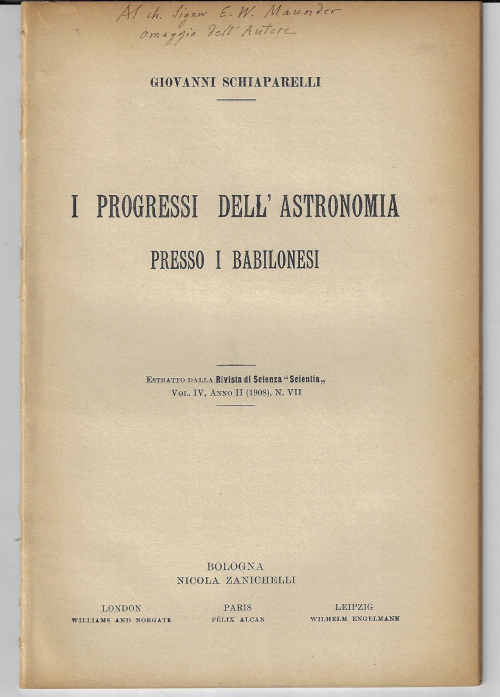 Giovano Schiaparelli, "I progressi dell'Astronomia presso i Babilonesi". Offprint from Rivisia di Scienza "Scientia", vol IV, anno II, VII, 1908. Bologna, Nicola Zanichelli. 235x160mm, 33pp. With the presentation inscription:
Giovano Schiaparelli, "I progressi dell'Astronomia presso i Babilonesi". Offprint from Rivisia di Scienza "Scientia", vol IV, anno II, VII, 1908. Bologna, Nicola Zanichelli. 235x160mm, 33pp. With the presentation inscription:
"Al Ch. Sign. E.W. Maunder Omaggio dell 'Autore" (Signed to Signore E.W. Maunder with the Homage of the Author)
This in an offprint, for sure, and it looks as though it was bound together with others at some point as the spine shows some signs of having been bound. A Good+ copy with a little browning around the edges. $500
Schiaparelli died 12 years after the introduction of Wells' War of the Worlds, and in the year of Halley's Comet, 1910.
Presentation copy to Walter Maunder from Schiaparelli, now today chiefly remembered as the unwitting and unwanted father of ET life on Mars. Schiaparelli I imagine was no doubt hugely pissed being remembered for what is essentially an error in translating his "canali" ("channels") observations of the Martian surface into "canals"--and thus giving birth to the idea that someone on Mars was building something. As an historian of science as well as an astronomer, I can only imagine how annoying that must've been for the man.
"Among Schiaparelli's (1835-1910) contributions are his telescopic observations of Mars. In his initial observations, he named the "seas" and "continents" of Mars. During the planet's "Great Opposition" of 1877, he observed a dense network of linear structures on the surface of Mars which he called "canali" in Italian, meaning "channels" but the term was mistranslated into English as "canals". While the term "canals" indicates an artificial construction, the term "channels" connotes that the observed features were natural configurations of the planetary surface. From the incorrect translation into the term "canals", various assumptions were made about life on Mars; as these assumptions were popularized, the "canals" of Mars became famous, giving rise to waves of hypotheses, speculation, and folklore about the possibility of intelligent life on Mars, the Martians."
Signed to "E.W. Maunder": Walter Maunder (1851-1928) was a British astronomer best remembered for his study of sunspots and the solar magnetic cycle that led to his identification of the period from 1645 to 1715 that is now known as the Maunder Minimum.




Comments